Today we had lined up to do a walking tour with our new friend Ceri – pronounced, ‘Kerry’, he’s a pretty cool, (and very cheeky), Canadian dude, with a Welsh name and a British accent, living in Argentina with English wife, who makes shoes for a living and does tour guiding on the side (or perhaps it’s the other way around). He’s also a photographer, an outspoken democratic socialist and speaks English, Spanish, French, and the language of ‘love’! Yes… he actually said that. 🙂 Right off the bat, we could tell Ceri was quite the character as he starting taking the piss within minutes of meeting us. A bold move for a tour guide… I can imagine American pax love that shit..! Personally, I found him to be intelligent, genuine and charming. So off we went to explore the city to check out the architecture, a tiny bit of history and some of his favourite spots.
A couple of blocks from the hotel, we stopped at the Embassy of the Austro-Hungarian Empire, such that it was (the Empire not the Embassy). It was built prior to WWI in a German neo-gothic style is one of Buenos Aires most imposing buildings. It is unfortunately not open to the public and houses boring office spaces now, but apparently is really lovely inside. The sculpture surrounding the building is quite impressive with figurative motifs of the architects and people involved in the building of the structure, along with decorative motifs of owls, phoenix and other creatures in among the stonework.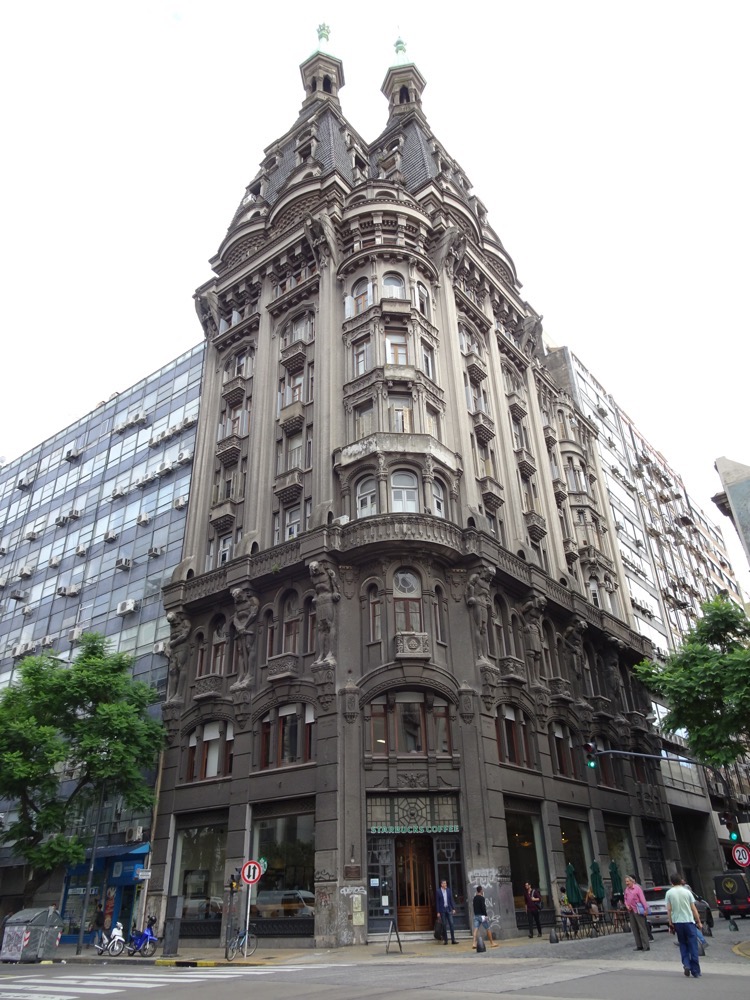 One of our next stops was the Parque Lezama… where we roundly ignored the statue of Pedro de Mendoza who allegedly founded the city of Buenos Aires in 1536, and went instead wandering the back streets to find a cafe. Being Australian, Ceri thought we’d want to find ‘good coffee’. It is apparently the one thing that Australians want when they get here and so he took us to a cafe- where we ordered one lemonade, one iced tea and one iced coffee, as I don’t drink coffee at all and none of us are big coffee drinkers. It was at this point, he questioned if we were actually Australian.
One of our next stops was the Parque Lezama… where we roundly ignored the statue of Pedro de Mendoza who allegedly founded the city of Buenos Aires in 1536, and went instead wandering the back streets to find a cafe. Being Australian, Ceri thought we’d want to find ‘good coffee’. It is apparently the one thing that Australians want when they get here and so he took us to a cafe- where we ordered one lemonade, one iced tea and one iced coffee, as I don’t drink coffee at all and none of us are big coffee drinkers. It was at this point, he questioned if we were actually Australian.
While at the markets we met the local butcher who provides all the meat for the nearby Argentinian steakhouses, a grocer and a local wine merchant, who promptly pulled out a bottle of local white wine, a Bodega-Colomé Torrontés 2016 and four glasses. It’s roughly about 10:30am at this point, but sure why not. The wine comes from the Calchaqui Valley and I must say, it was excellent regardless of the hour. Our wine merchant friend didn’t try to sell us anything, just watched us raise a glass and wished us a good day. From here we made our way towards the Casa Rosada.
Streetscapes near the Parque Lezama…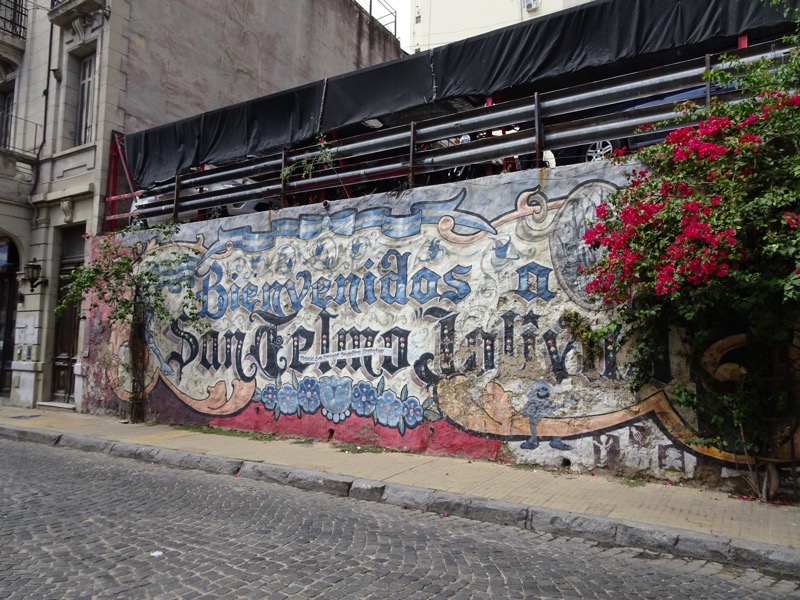
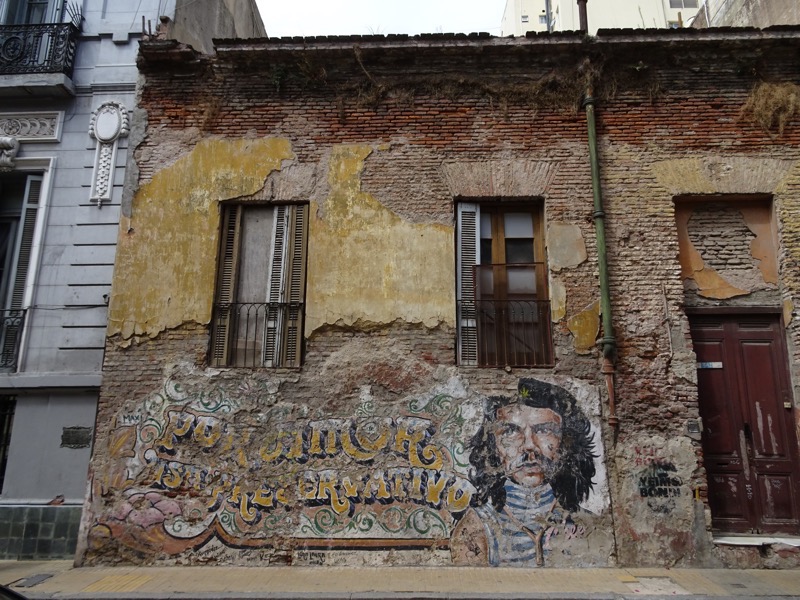 Random window above the street level near Defensor – makes me feel like the repair work I need to do on my own home isn’t so desperate after all.
Random window above the street level near Defensor – makes me feel like the repair work I need to do on my own home isn’t so desperate after all.
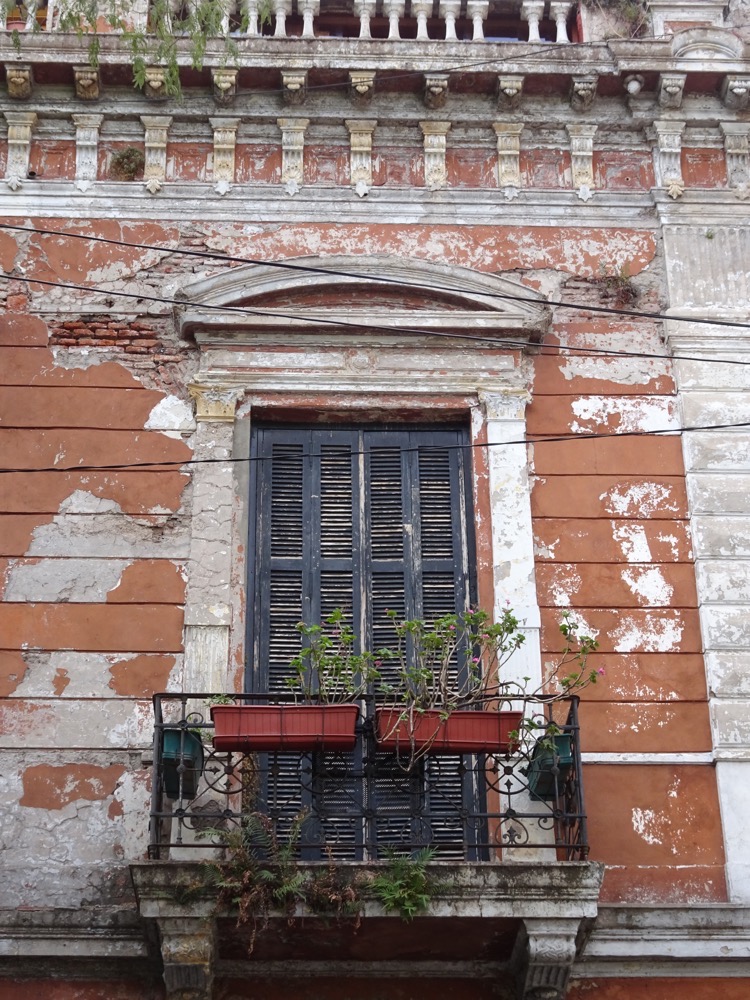 The streets on the way to Casa Rosada – the famous Presidential Palace, were increasingly congested with all the protesting that was going on. The Casa Rosada was so busy and surrounded by so much construction, clumps of cruise ship tourists, traffic and chaos that I have stolen… err appropriated, a pic from Wikipedia to include here so you can actually see (and so that I will be able to remember) what the building it is supposed to look like!
The streets on the way to Casa Rosada – the famous Presidential Palace, were increasingly congested with all the protesting that was going on. The Casa Rosada was so busy and surrounded by so much construction, clumps of cruise ship tourists, traffic and chaos that I have stolen… err appropriated, a pic from Wikipedia to include here so you can actually see (and so that I will be able to remember) what the building it is supposed to look like!
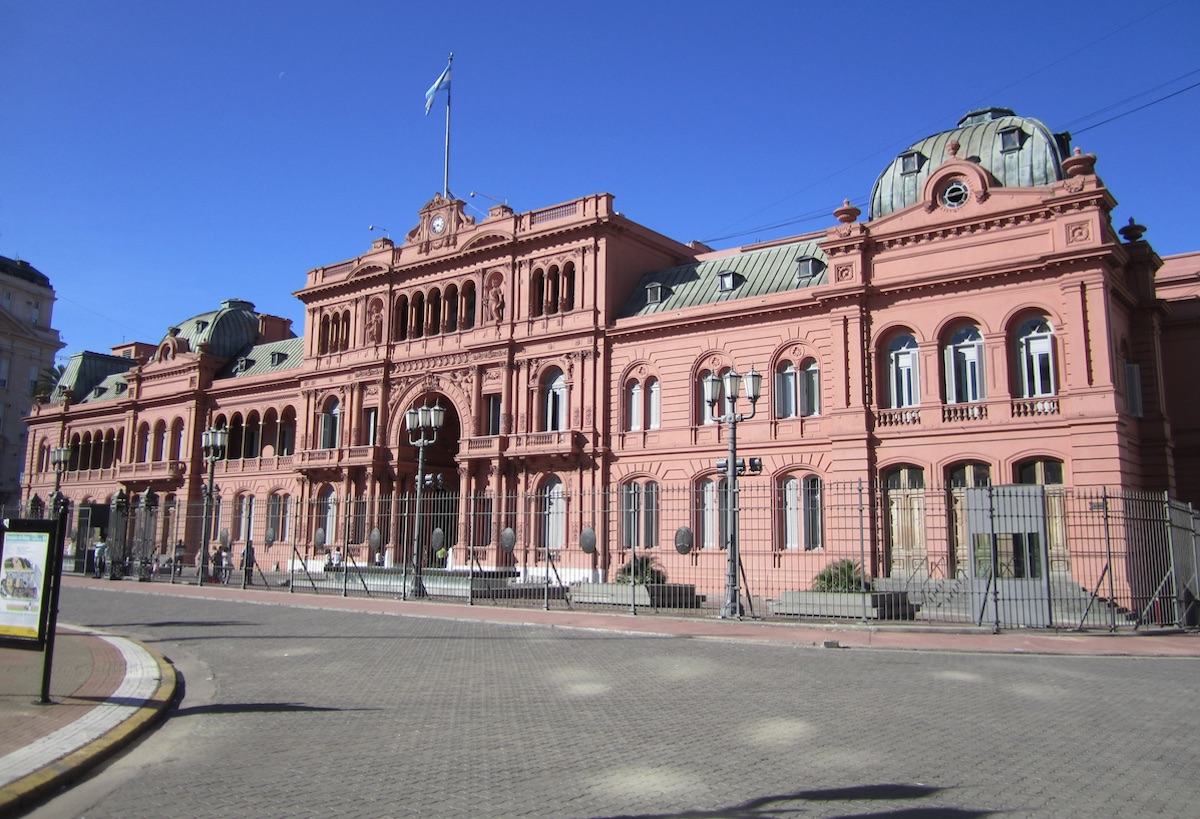 We sat on some steps opposite the Palace and had a discussion about the building, and rebuilding of the Palace over the years, the state of Argentinian politics, and discussed some of the different approaches that Argentina vs Australia take to global problems. For example on immigration – Argentina is seeing a lot of Venezuelan immigrants at the moment as a result of instability in that region and rather than take those refugees and ship them offshore to detention hellholes, the Argentinan government is expediting visas and citizenships for these people primarily because they bring skills and abilities to the country, but there’s an added benefit that it is apparently pissing off the Venezuelan government to no end.
We sat on some steps opposite the Palace and had a discussion about the building, and rebuilding of the Palace over the years, the state of Argentinian politics, and discussed some of the different approaches that Argentina vs Australia take to global problems. For example on immigration – Argentina is seeing a lot of Venezuelan immigrants at the moment as a result of instability in that region and rather than take those refugees and ship them offshore to detention hellholes, the Argentinan government is expediting visas and citizenships for these people primarily because they bring skills and abilities to the country, but there’s an added benefit that it is apparently pissing off the Venezuelan government to no end.
After attempting to save the world’s global refugee crisis and failing miserably, we moved onto the Buenos Aires Metropolitan Cathedral, which was also surrounded by barricades getting ready for some social protest or other – Ceri tells us that protesting is pretty much a national Argentinian past time at this point. That there are protests for something or other, literally every day. It stems from many of today’s Argentinians being still very much mindful of their recent dictactorial political situation as recently as the 1980s. We touched briefly on the Falklands War which we were informed was largely an enormous attempt at misdirection by a corrupt government to keep the populace from looking too hard at what was going on (which reinforces what we were told by the Falklanders we met in Stanley last year).
Anyway, the Cathedral is mostly known now as the home parish for the current Pope who was the Archbishop here before being elected to the Papacy. The locals are extraordinarily proud of their Pope – and rightly so I think, he’s a vast improvement over the last few – and they talk of his humility and charity with great fondness and enthusiasm.
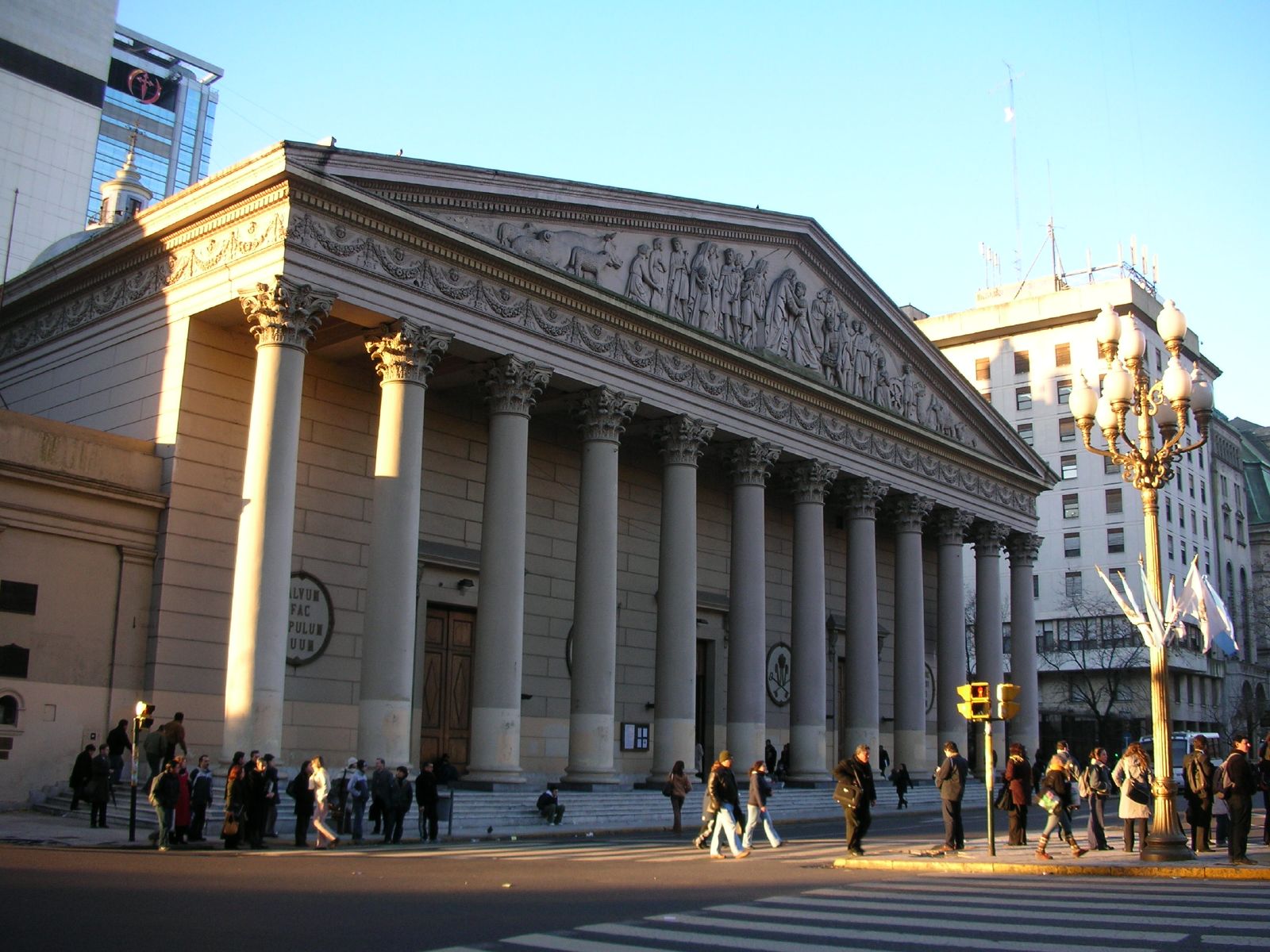
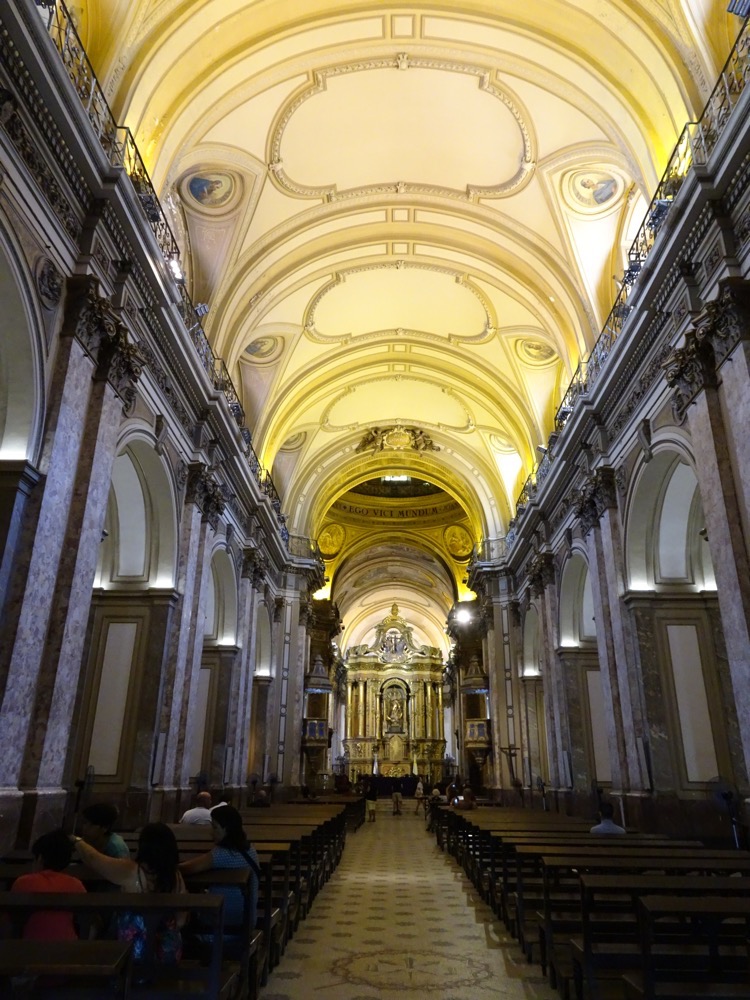
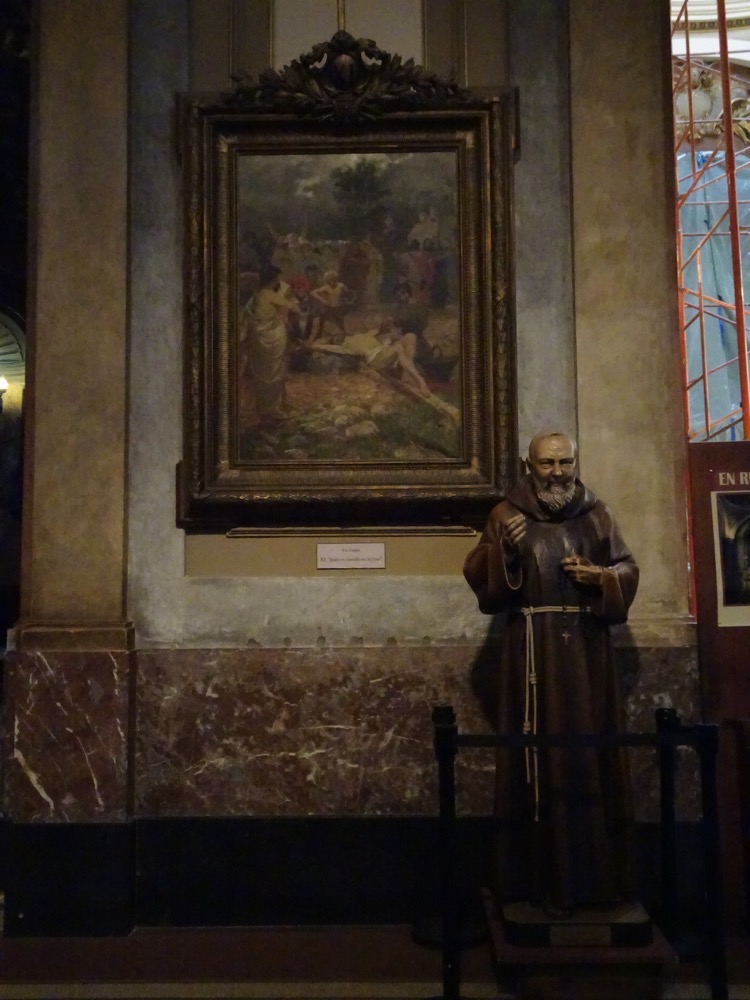
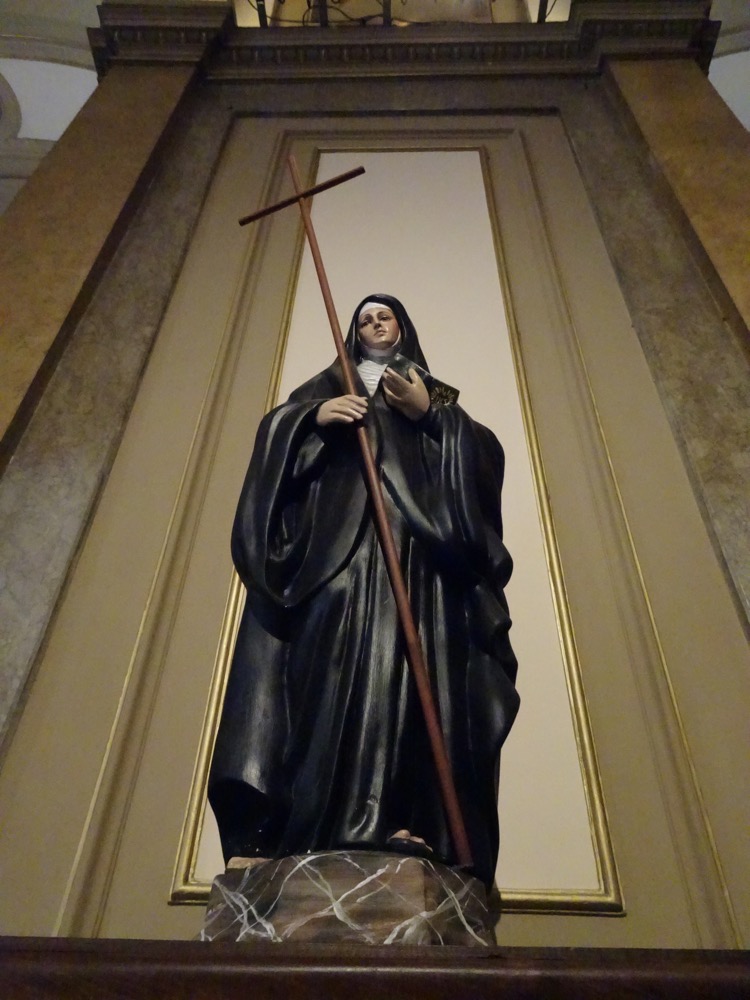
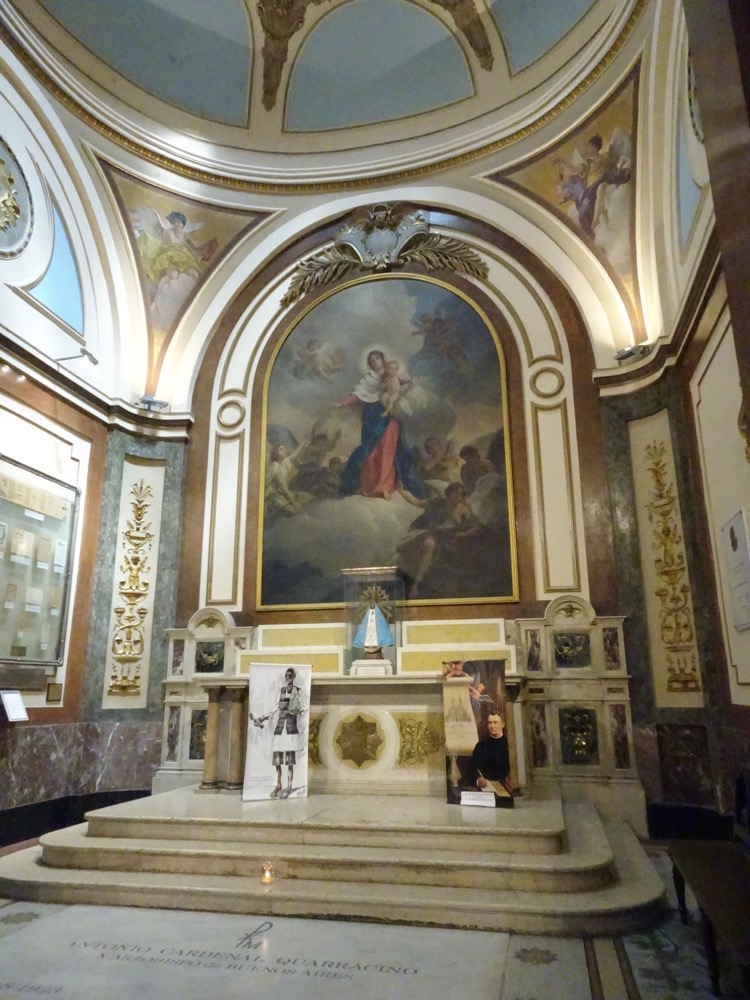 The Cathedral fronts directly onto the Plaza del Mayo which is a large open space often used for protesting… most notably it is the site where the ‘Mothers of the Plaza de Mayo’ congregate every Thursday as they have done since the mid-1980s. The Mothers of the Plaza de Mayo have been turning up protesting that they do not know what has happened to their children and the tens of thousands of people who were ‘disappeared’ between 1976 and 1983. At that time, anyone who protested against the dictatorial government would find themselves ‘disappeared’. Protesting was outlawed and protestors were kidnapped, tortured and murdered (apparently a favoured way to get rid of political dissidents was to torture them and then to fly them over the River Plata and throw them out of planes) This state-run terrorism campaign of the military dictatorship operated between 1976 and 1983, which is when the Mothers of the Plaza de Mayo organised and started to protest the disappearance of their children. You see the very Catholic Argentinians adore and respect their mothers above all else and they knew that no Argentinians would stand idle if they saw mothers being beaten and subdued in the streets. So the government just had to let them alone… and while protesting is now completely legal, the Mothers have refused to be silent and they continue to protest nearly 40 years on.
The Cathedral fronts directly onto the Plaza del Mayo which is a large open space often used for protesting… most notably it is the site where the ‘Mothers of the Plaza de Mayo’ congregate every Thursday as they have done since the mid-1980s. The Mothers of the Plaza de Mayo have been turning up protesting that they do not know what has happened to their children and the tens of thousands of people who were ‘disappeared’ between 1976 and 1983. At that time, anyone who protested against the dictatorial government would find themselves ‘disappeared’. Protesting was outlawed and protestors were kidnapped, tortured and murdered (apparently a favoured way to get rid of political dissidents was to torture them and then to fly them over the River Plata and throw them out of planes) This state-run terrorism campaign of the military dictatorship operated between 1976 and 1983, which is when the Mothers of the Plaza de Mayo organised and started to protest the disappearance of their children. You see the very Catholic Argentinians adore and respect their mothers above all else and they knew that no Argentinians would stand idle if they saw mothers being beaten and subdued in the streets. So the government just had to let them alone… and while protesting is now completely legal, the Mothers have refused to be silent and they continue to protest nearly 40 years on.
After this depressing stop, we went for a wander off to pop into the famous Cafe Tortoni. The Cafe Tortoni is on the Avenida de Mayo – built in the mid-1850s by a French immigrant whose name I have forgotten, it was the place to be for Parisien expats at the end of the 19thC. The whole street feels like you are walking down a Paris boulevard, and the cafe itself has a beautiful and elegant ‘belle epoque’ feel about it, which has attracted intellectuals and celebrities alike for over 150 years.
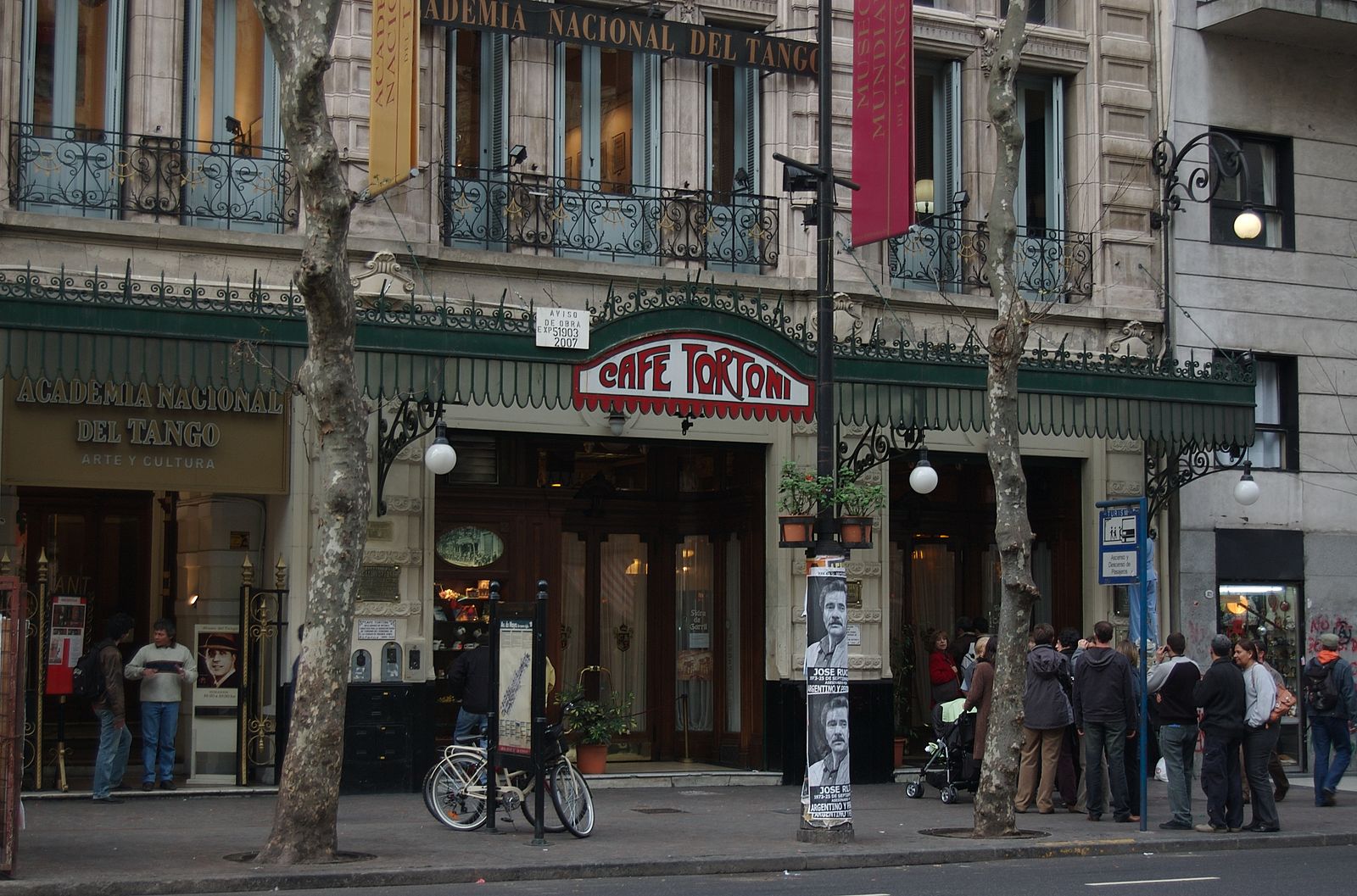
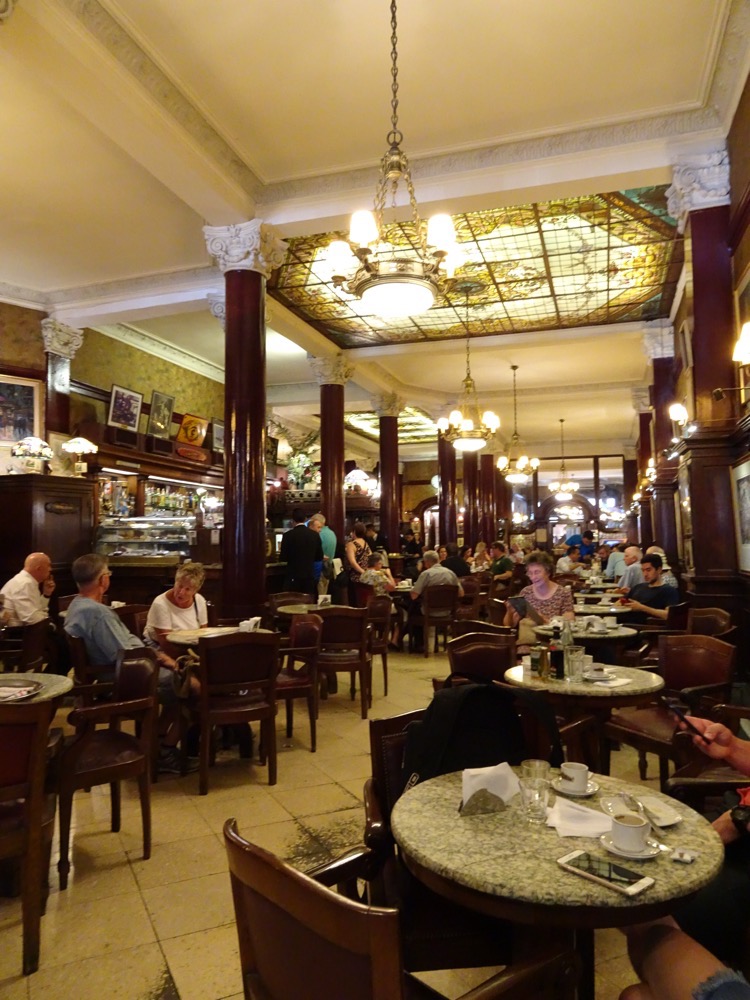 We stepped out of the cafe and ran smack bang into… wouldn’t you know it, a workers union protest. It was at this point I asked Ceri if all this political engagement and protesting ever brought about tangible change to which he replied, ‘Not really, but now they have their right to protest back, they’re intent on using it.’
We stepped out of the cafe and ran smack bang into… wouldn’t you know it, a workers union protest. It was at this point I asked Ceri if all this political engagement and protesting ever brought about tangible change to which he replied, ‘Not really, but now they have their right to protest back, they’re intent on using it.’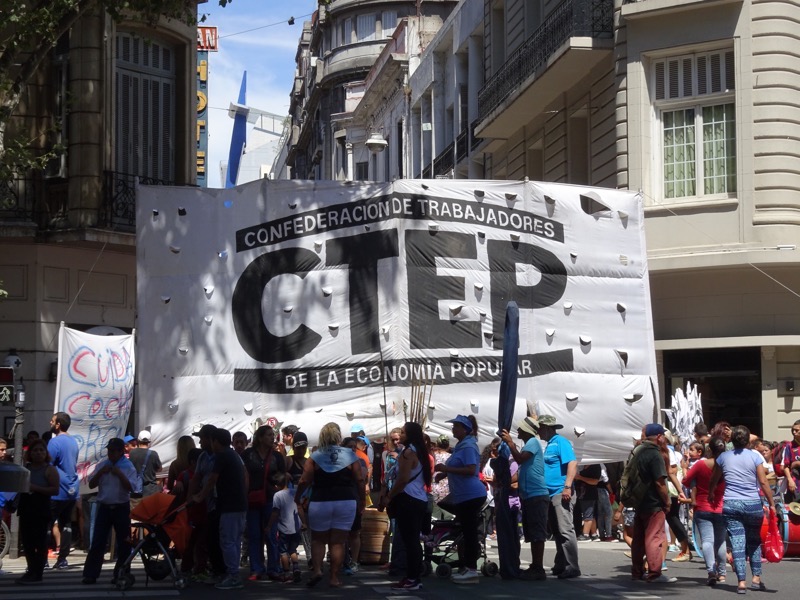 From here we made our way to 9 July Avenue where one of the famous Evita balconies is located as well as an enormous 70m obelisk. The Obelisco de Buenos Aires was erected in the Plaza de la República on 9 de Julio in 1936 to commemorate the quadricentennial of the foundation of the city. It’s quite a striking monument – you can’t miss it!
From here we made our way to 9 July Avenue where one of the famous Evita balconies is located as well as an enormous 70m obelisk. The Obelisco de Buenos Aires was erected in the Plaza de la República on 9 de Julio in 1936 to commemorate the quadricentennial of the foundation of the city. It’s quite a striking monument – you can’t miss it!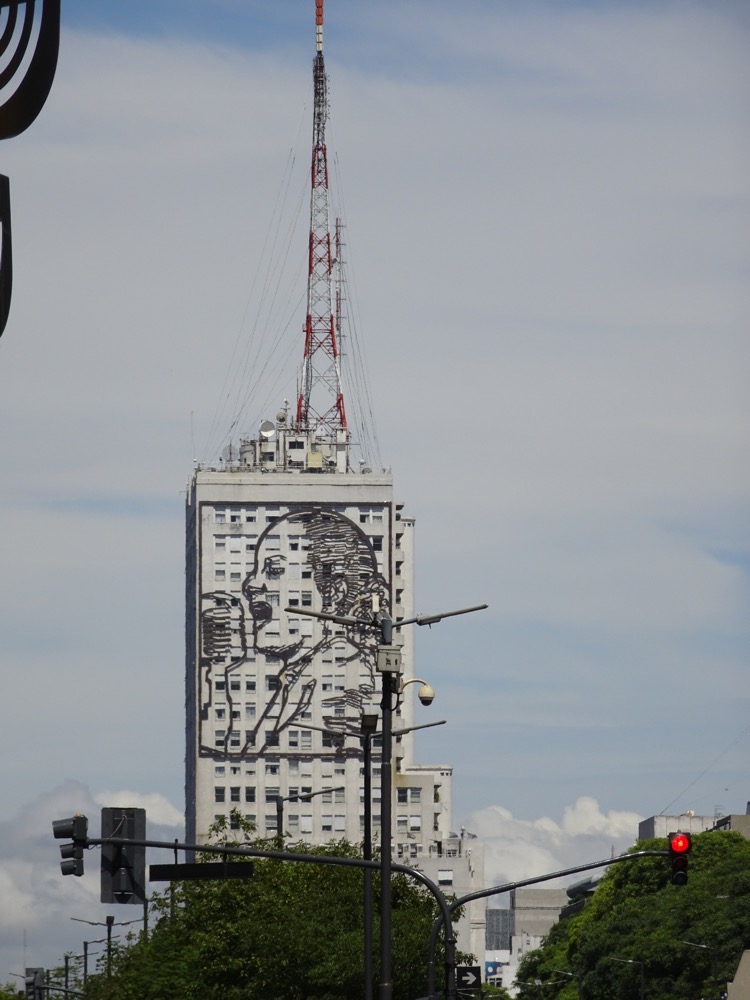
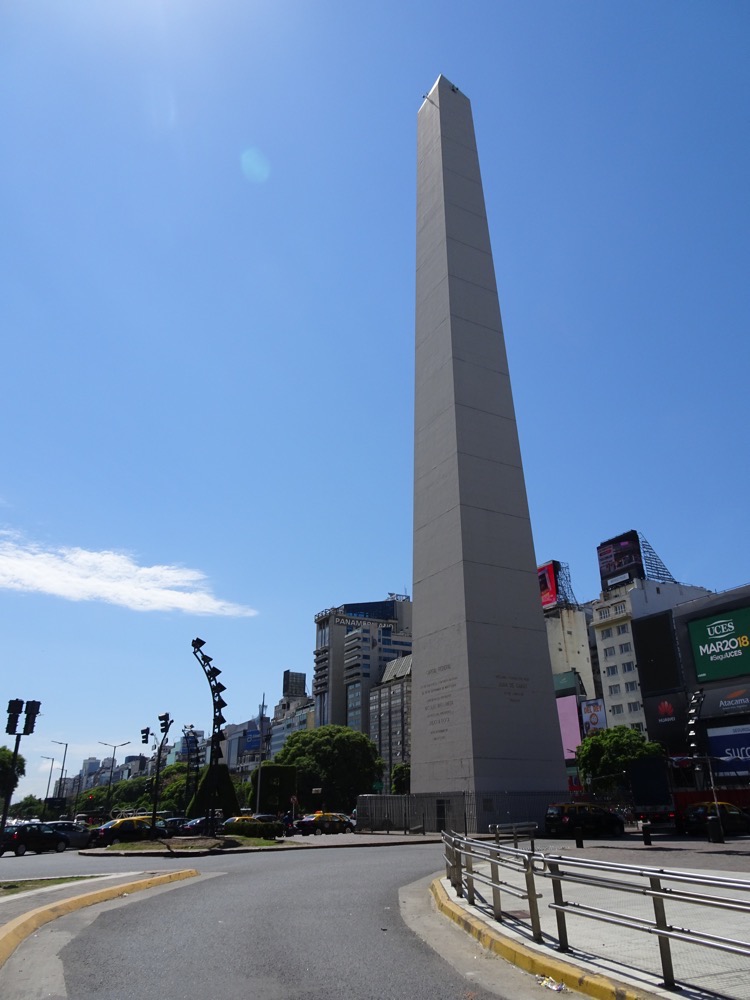
After this, we hopped a taxi to take us to the Recoleta Cemetary… because, well it was getting stupid hot and it was a couple of kilometres away.
The Recoleta Cemetery is mostly known as the resting place of Evita Peron, buried under her maiden name of Duarte. But aside from this one famous grave, the place is a photographers dream and I make no apologies for how many pics are included here of the beautiful artistry that has gone into creating the monuments to passed loved ones… the place is open-air sculpture and decorative arts musuem in its own right.
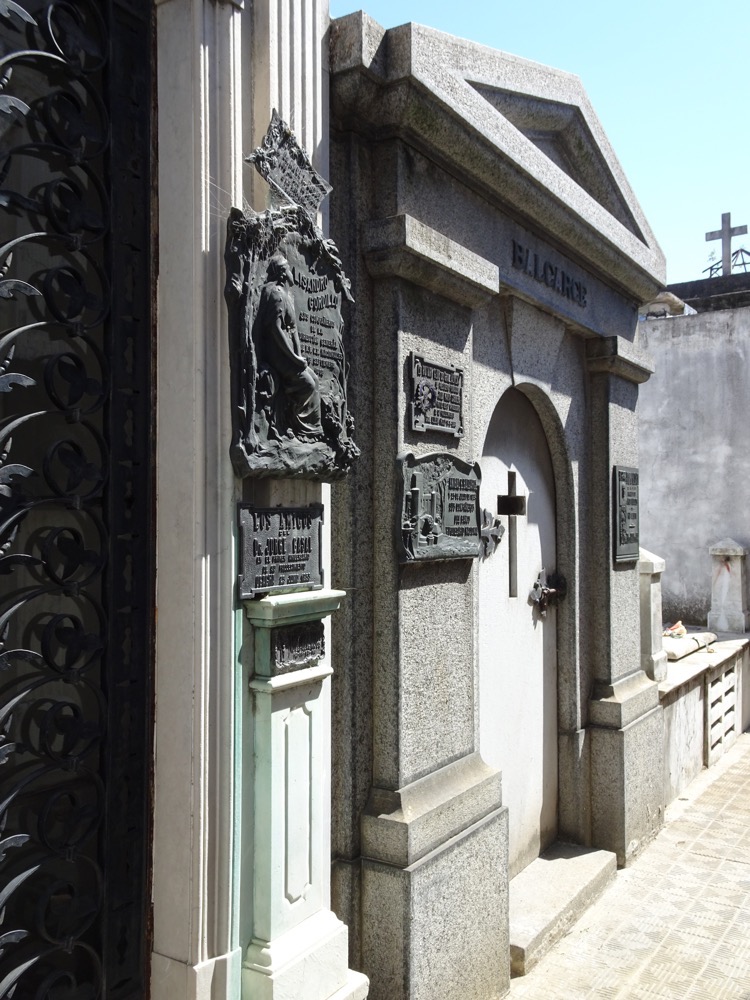 The large walled cemetery is similar to one we saw in Punta Arenas in Chile last year, but quite five times the size, and quite ten times as ostentatious in its display of wealth and status. The mausoleums are enormous, and all the materials and workmanship would have been imported from Europe.
The large walled cemetery is similar to one we saw in Punta Arenas in Chile last year, but quite five times the size, and quite ten times as ostentatious in its display of wealth and status. The mausoleums are enormous, and all the materials and workmanship would have been imported from Europe.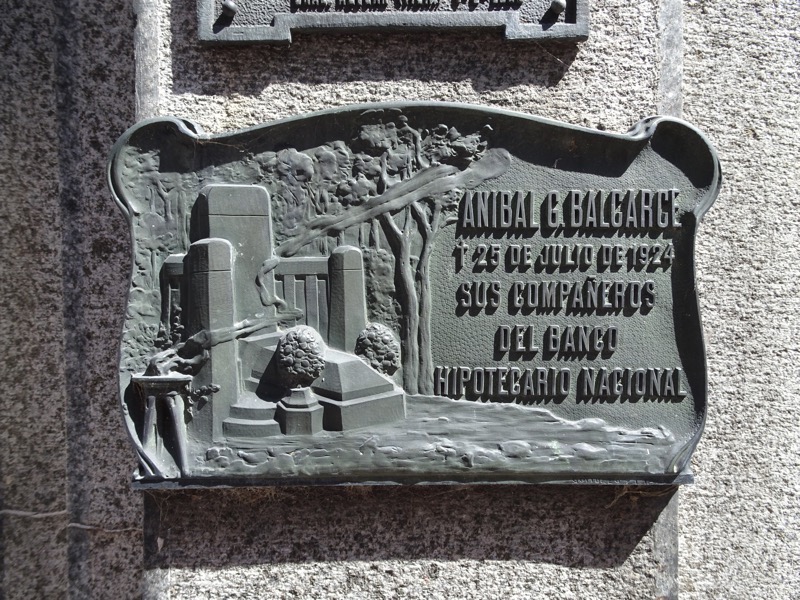
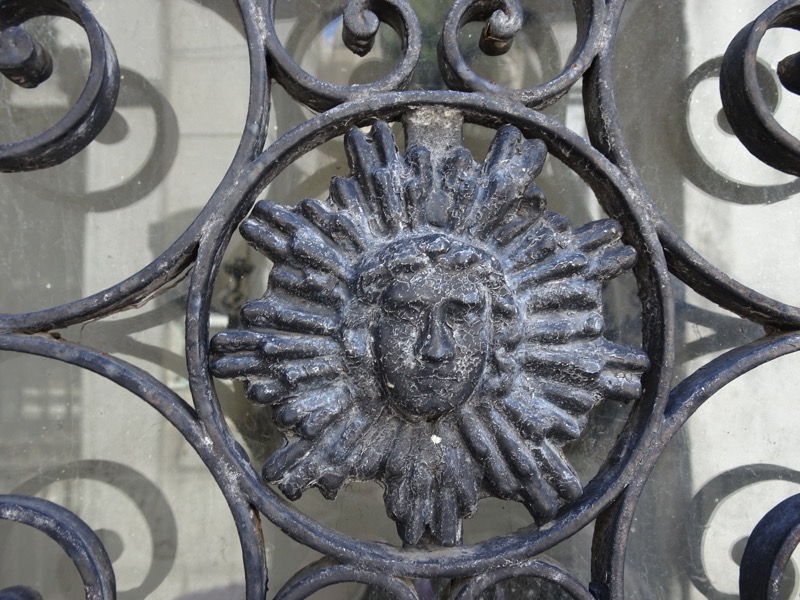
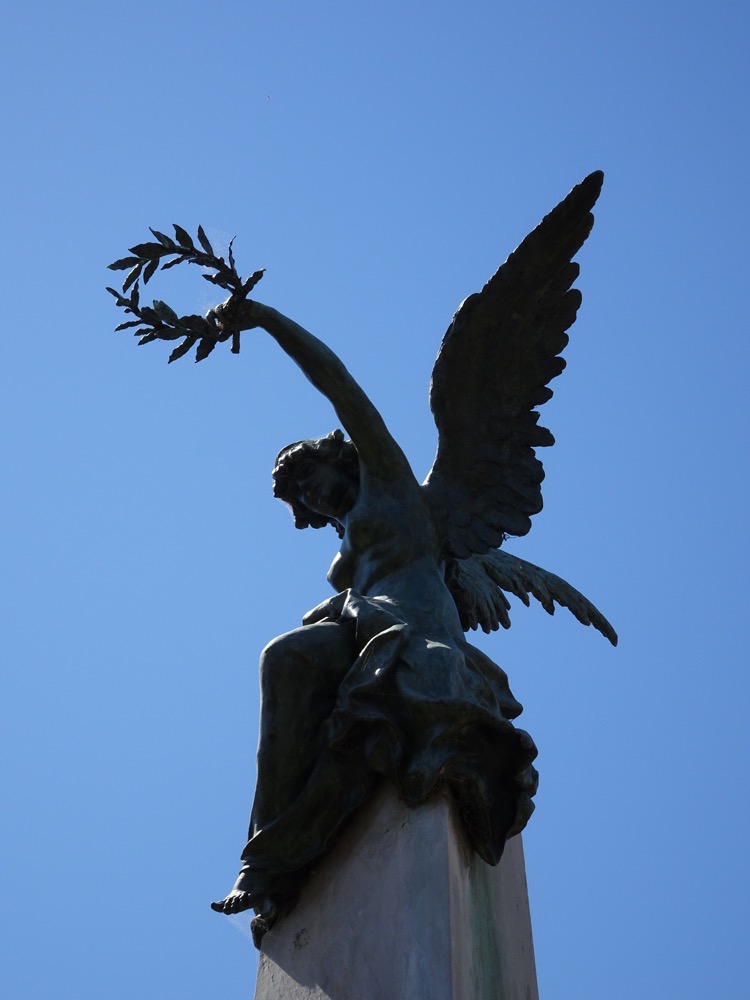
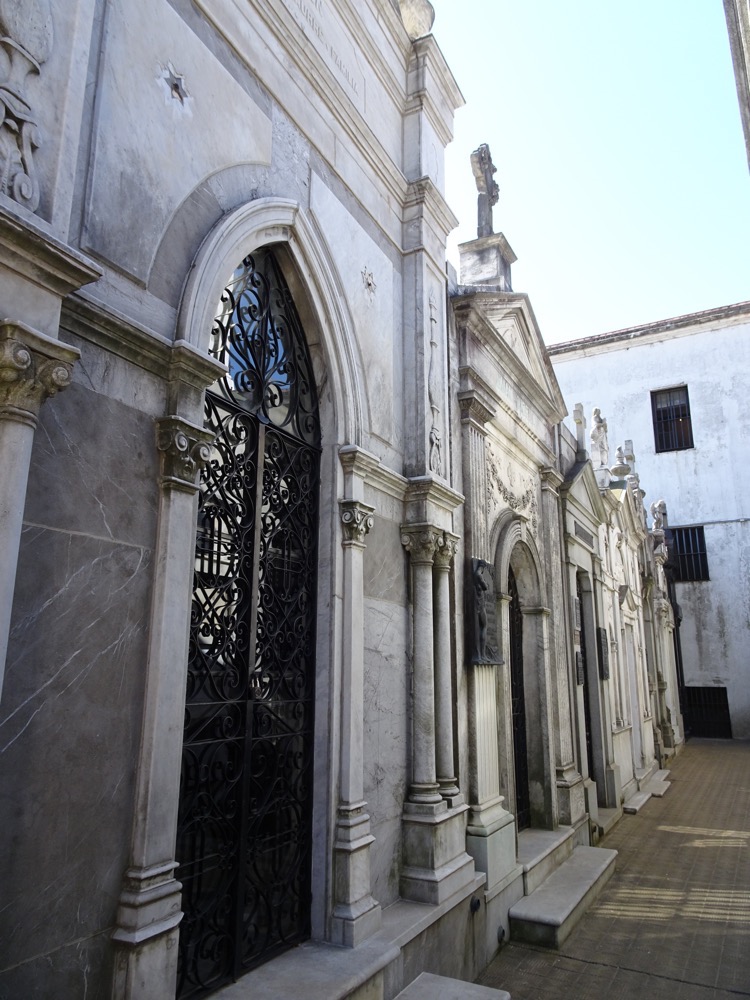
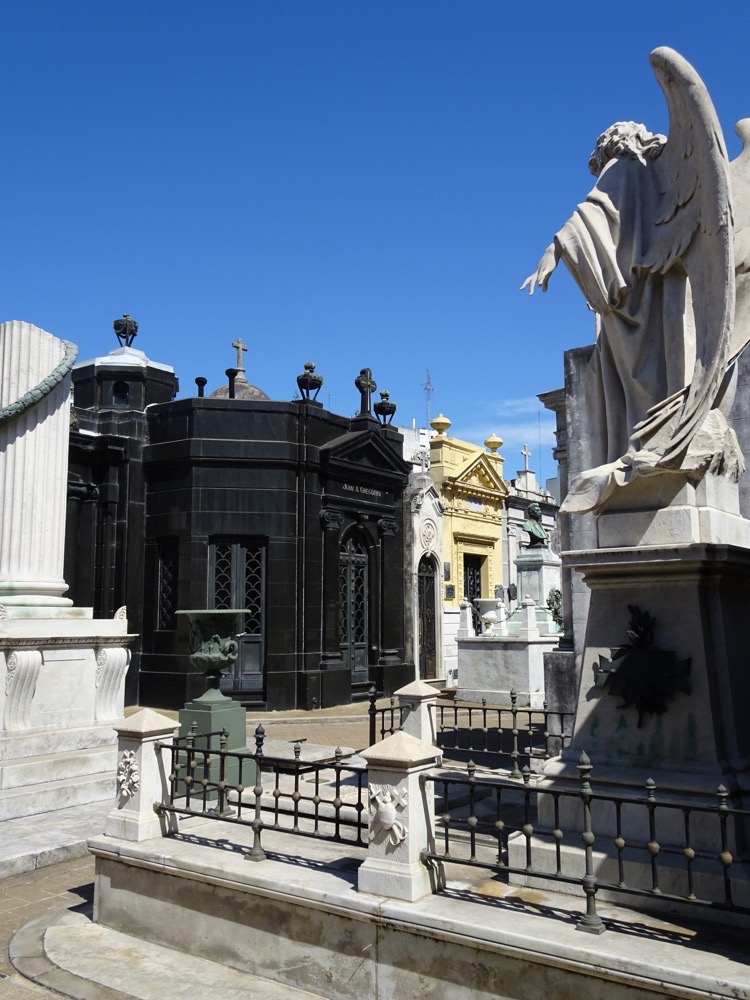 People from many different denominations are buried here. The Argentinians are a very cosmopolitan people having come from everywhere – this appears to have been the result of a dreadful policy that encouraged the slaughter of the indigenous peoples in the past, but has created a society that knows they are all from somewhere else, so they appear to be more tolerant of one another… Ceri claims the Argentines ‘are mostly Italian and Irish descent, speaking Spanish, dressing like French and wanting to be British.’
People from many different denominations are buried here. The Argentinians are a very cosmopolitan people having come from everywhere – this appears to have been the result of a dreadful policy that encouraged the slaughter of the indigenous peoples in the past, but has created a society that knows they are all from somewhere else, so they appear to be more tolerant of one another… Ceri claims the Argentines ‘are mostly Italian and Irish descent, speaking Spanish, dressing like French and wanting to be British.’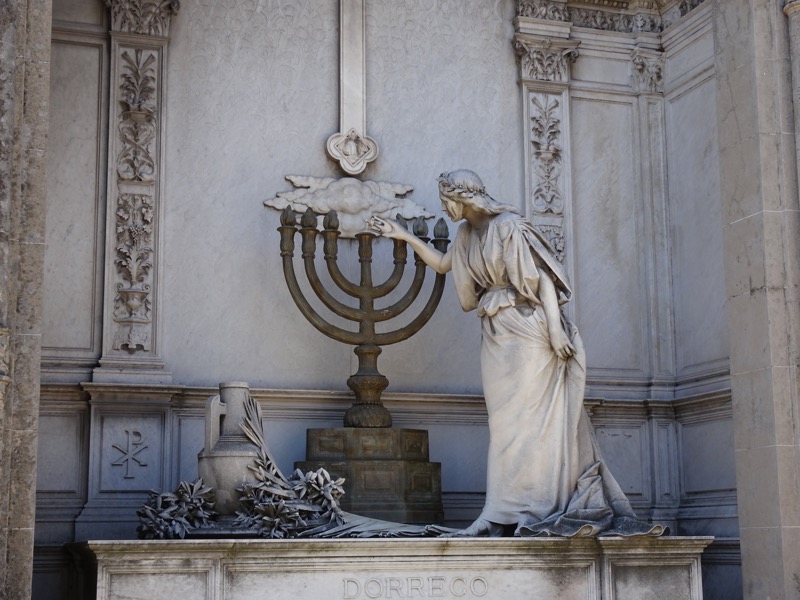
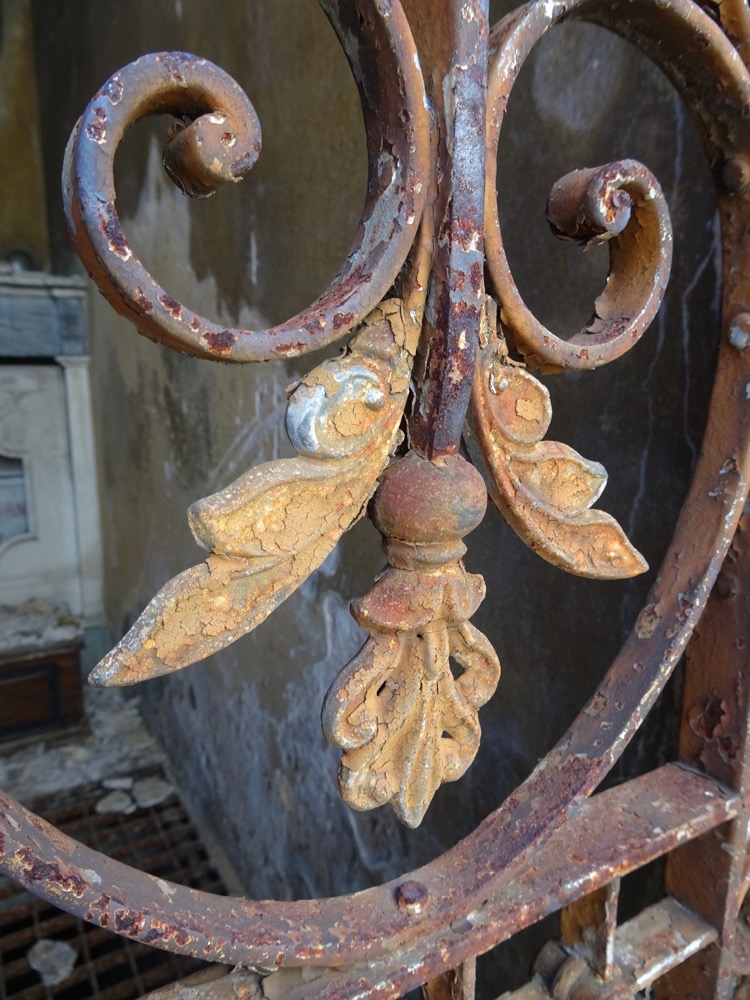 Presidente Alfonsin’s grave site – unlike most of the tombs here, this one is open sided and not locked.
Presidente Alfonsin’s grave site – unlike most of the tombs here, this one is open sided and not locked.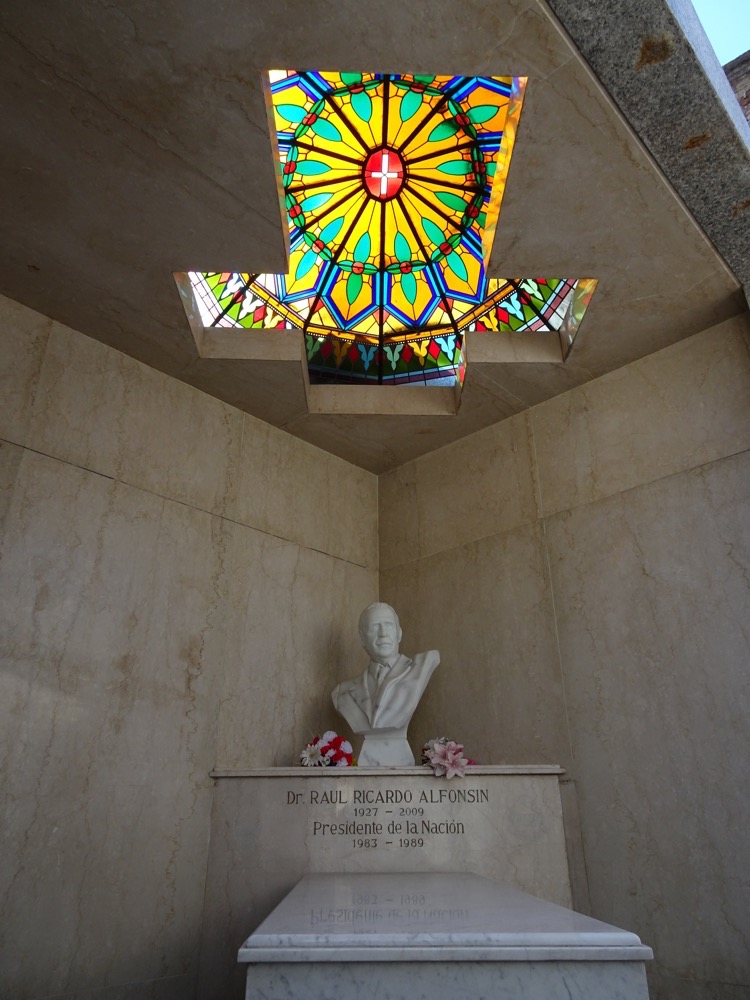
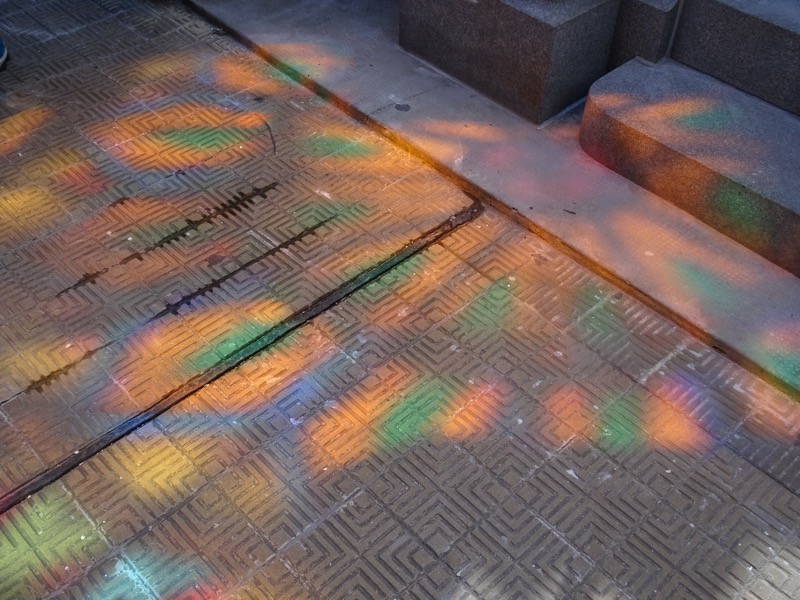
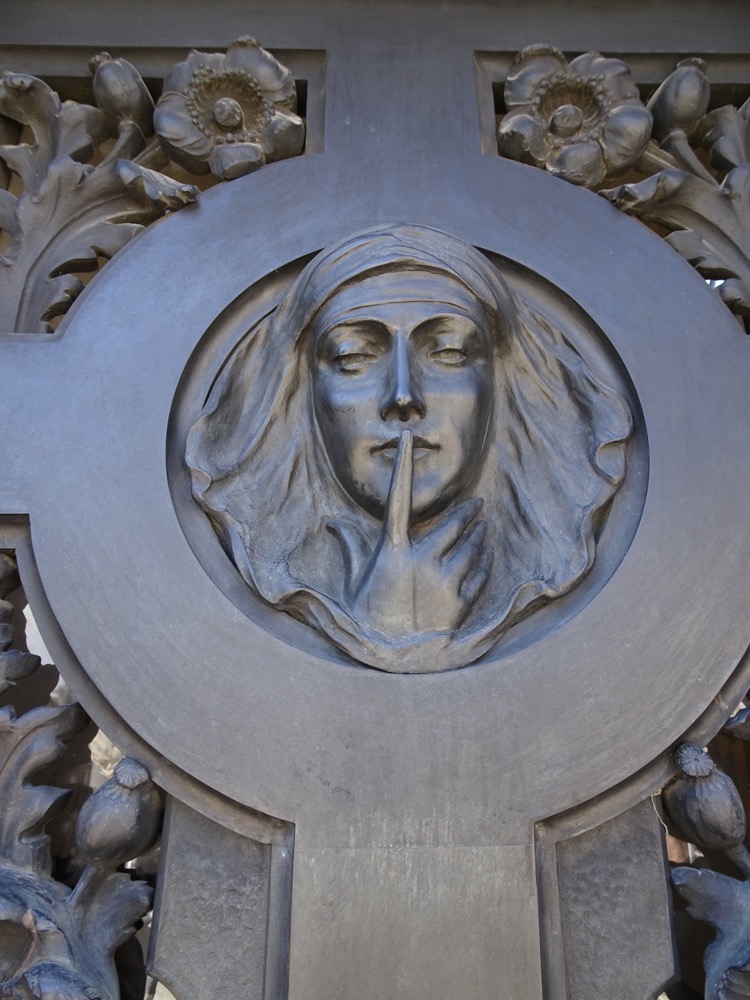
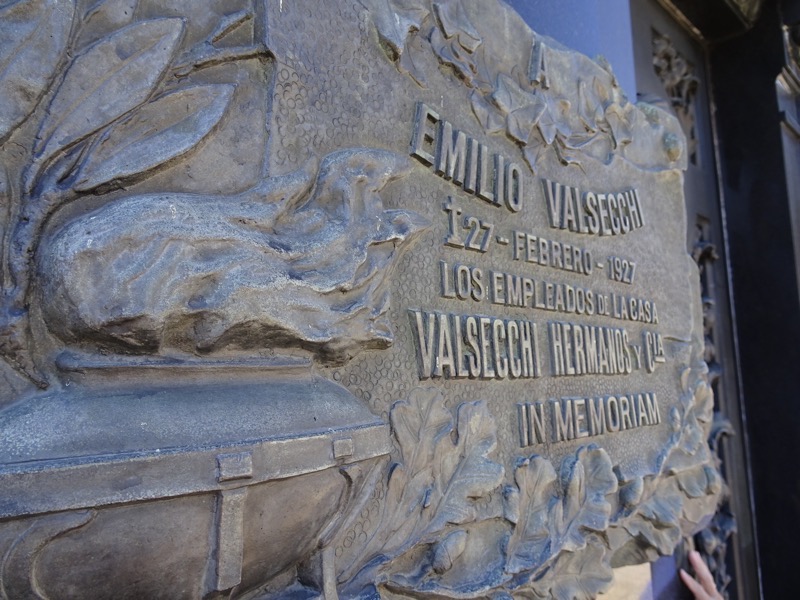 The graves are rich with symbolism – from trees of life, owls of wisdom, anchors of hope and memento mori.
The graves are rich with symbolism – from trees of life, owls of wisdom, anchors of hope and memento mori.
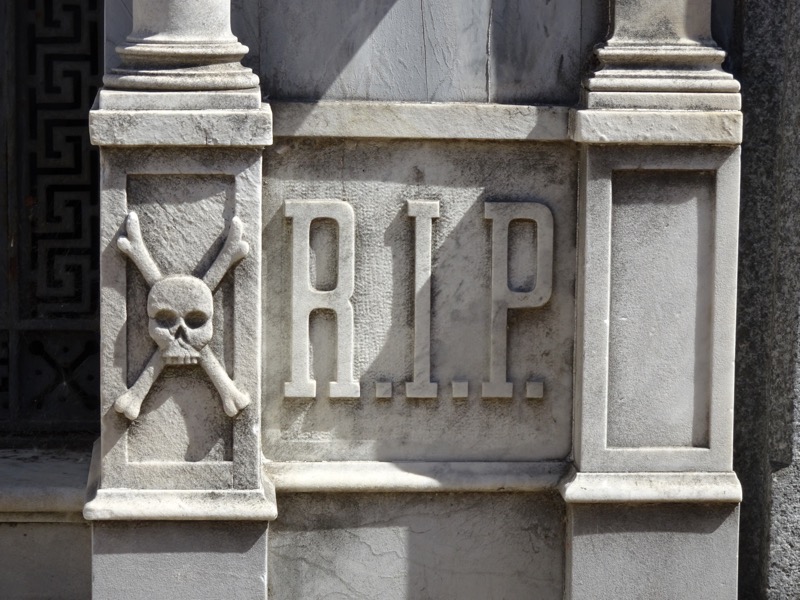
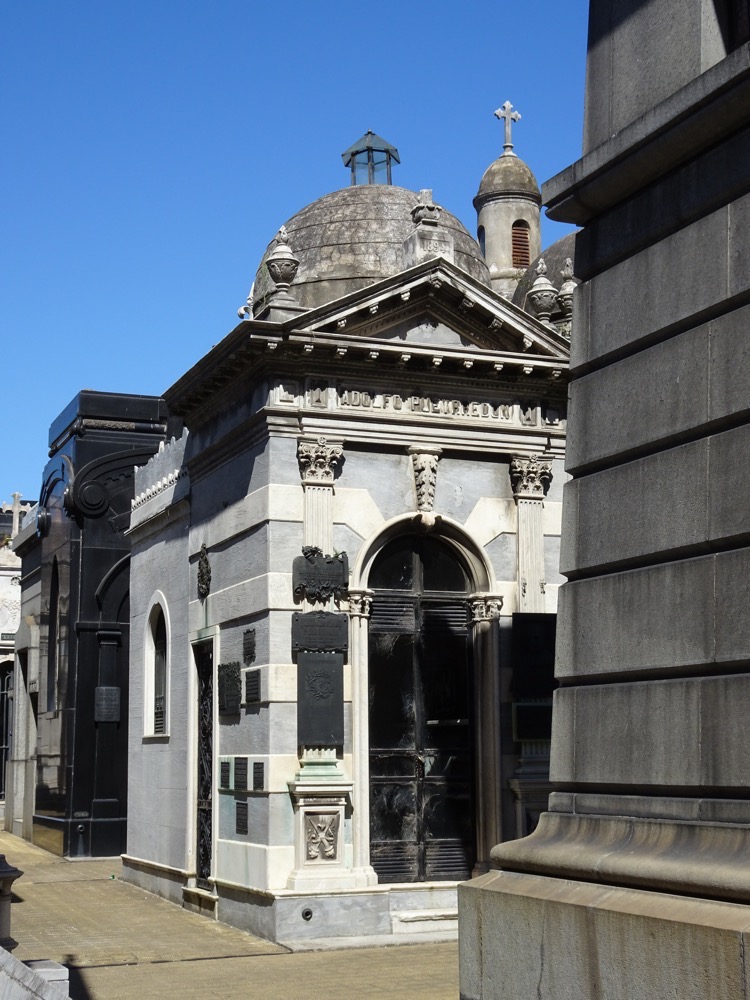 This is a couple who hated each other but who were forced to live out their lives together – Catholics do not divorce – so in death they chose to be buried in the family plot feet pointing towards each other and busts facing away, not side by side as most loving couples would. It’s very honest in its own way.
This is a couple who hated each other but who were forced to live out their lives together – Catholics do not divorce – so in death they chose to be buried in the family plot feet pointing towards each other and busts facing away, not side by side as most loving couples would. It’s very honest in its own way.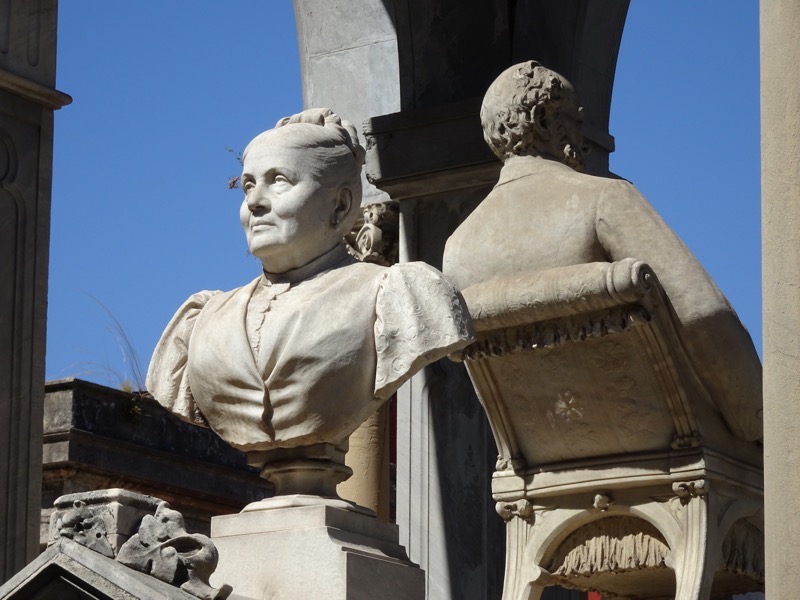
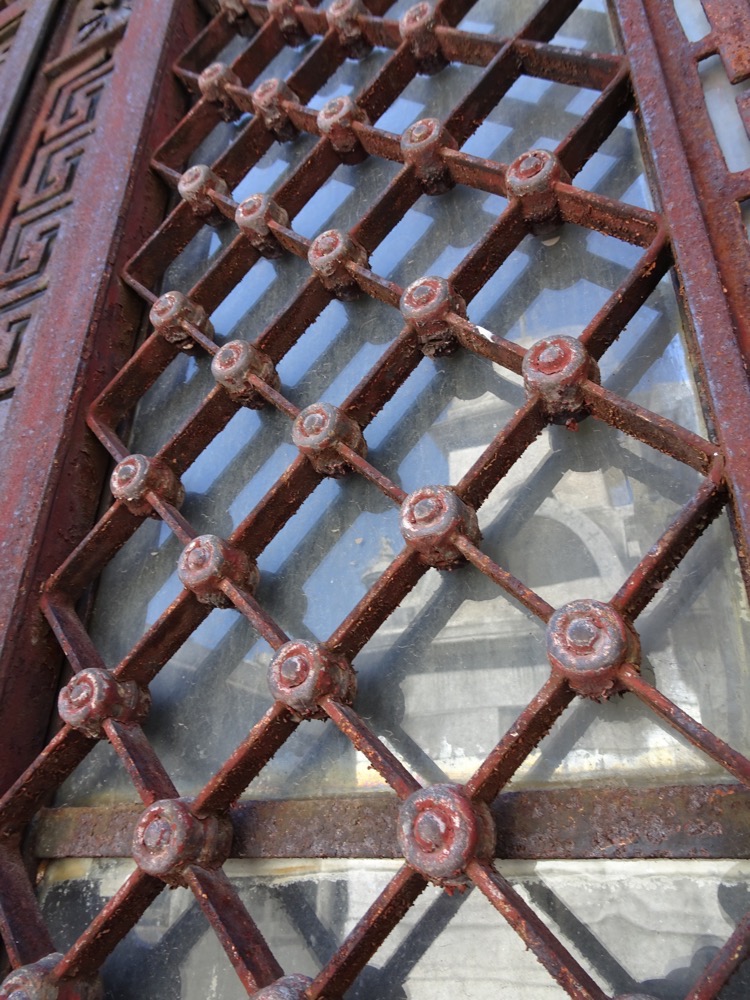
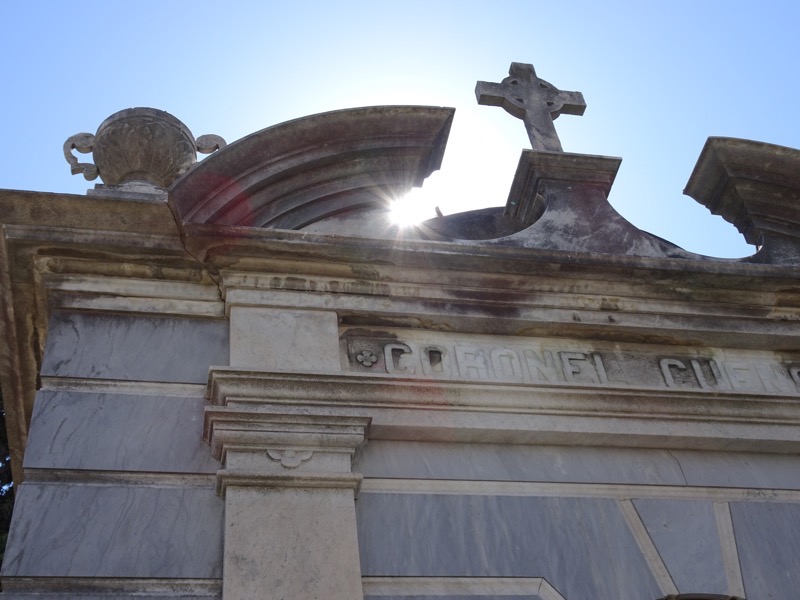
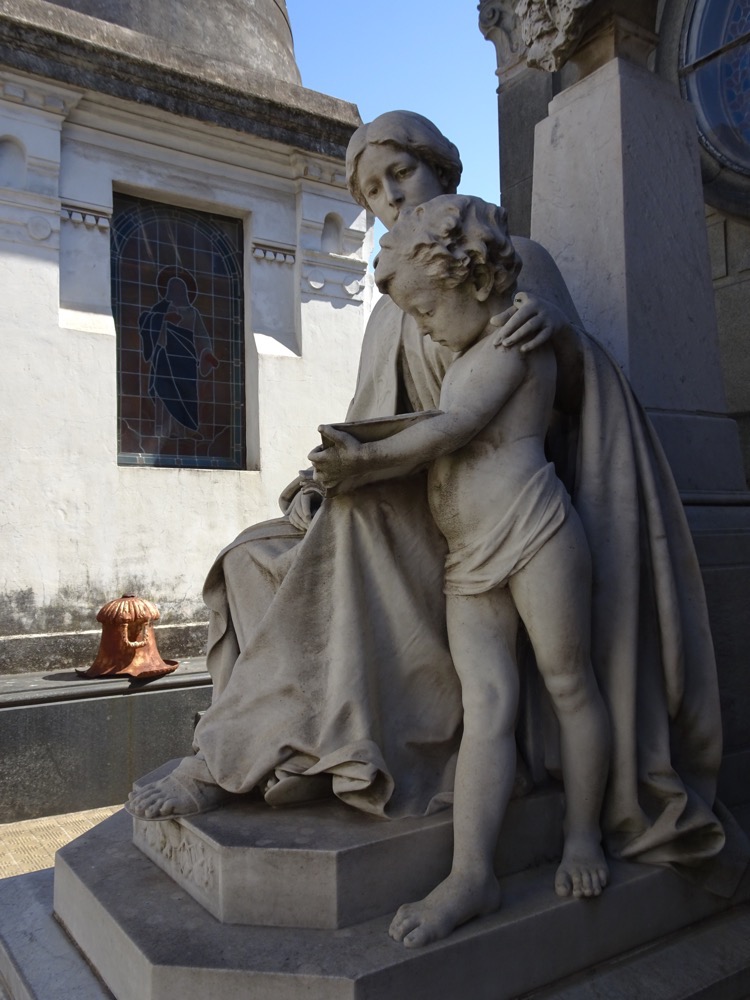
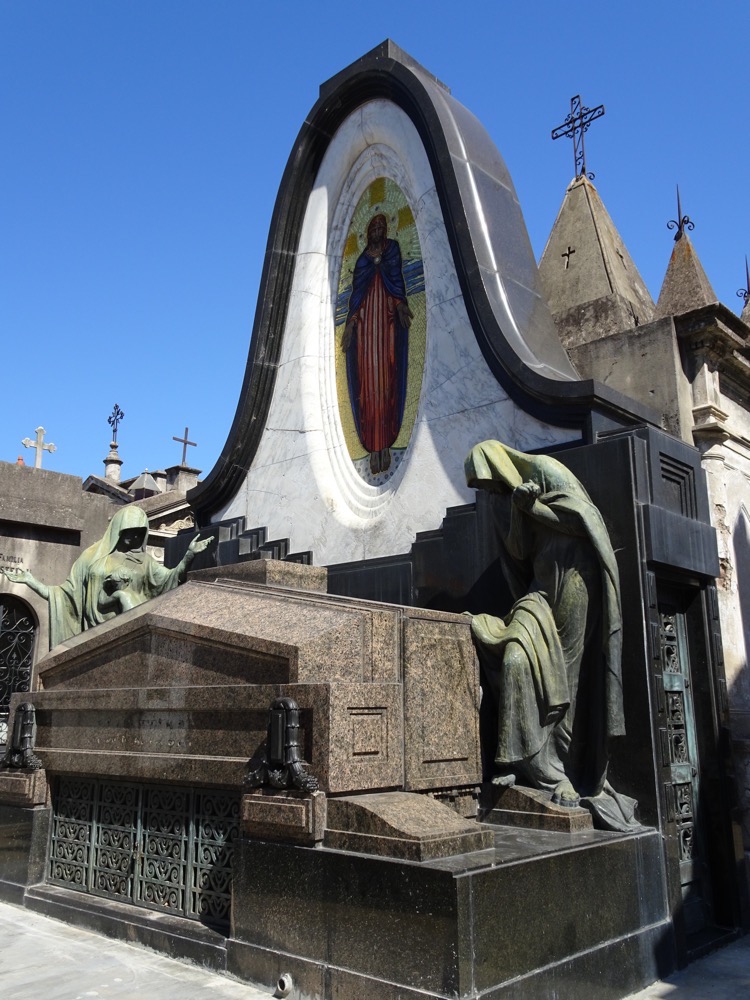
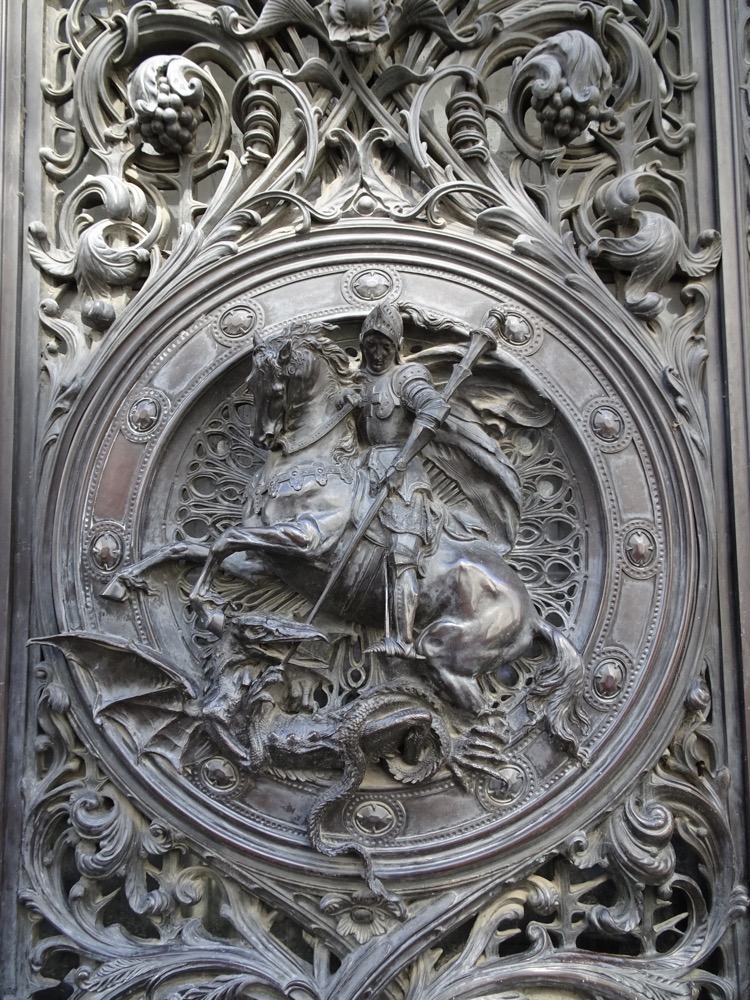
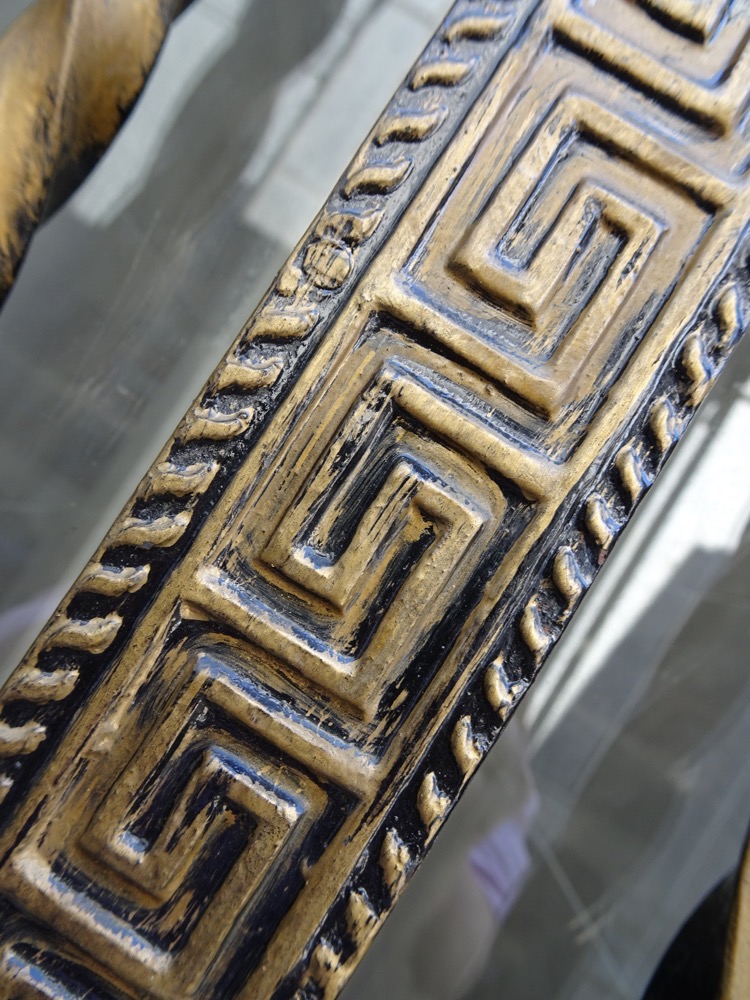 This is a momument to a woman named Ida – a very personal homage from a grieving husband. Ida fell from a building and this statue depicts a woman helping her into the heavens.
This is a momument to a woman named Ida – a very personal homage from a grieving husband. Ida fell from a building and this statue depicts a woman helping her into the heavens.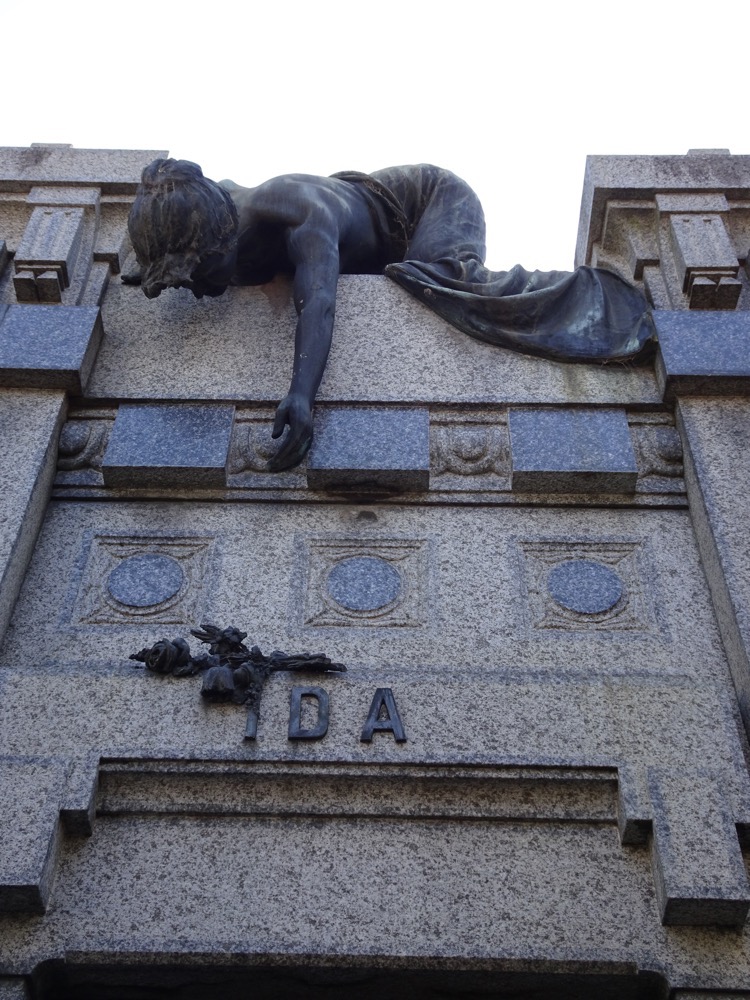 Eva Peron’s grave – the most visited grave in the cemetery. It is the only one covered in flowers and tokens, though compared to many of the other tombs, it is plain, simple and not particularly artistic. Evita was a very divisive figure so it is the only place in the cemetery that is under CCTV surveillance.
Eva Peron’s grave – the most visited grave in the cemetery. It is the only one covered in flowers and tokens, though compared to many of the other tombs, it is plain, simple and not particularly artistic. Evita was a very divisive figure so it is the only place in the cemetery that is under CCTV surveillance.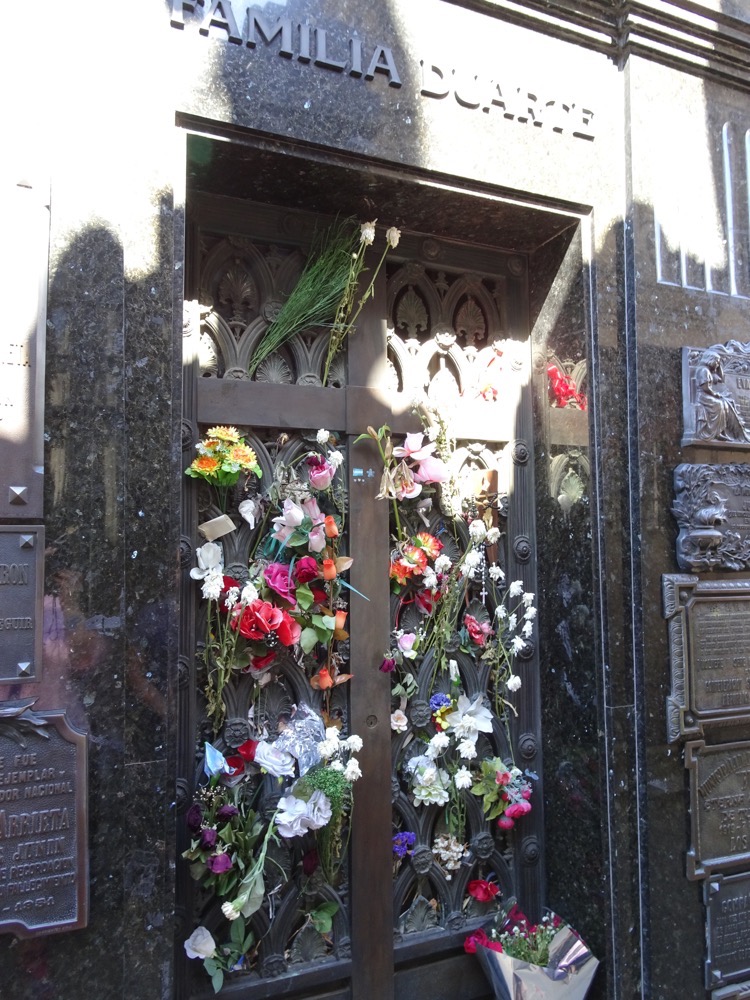
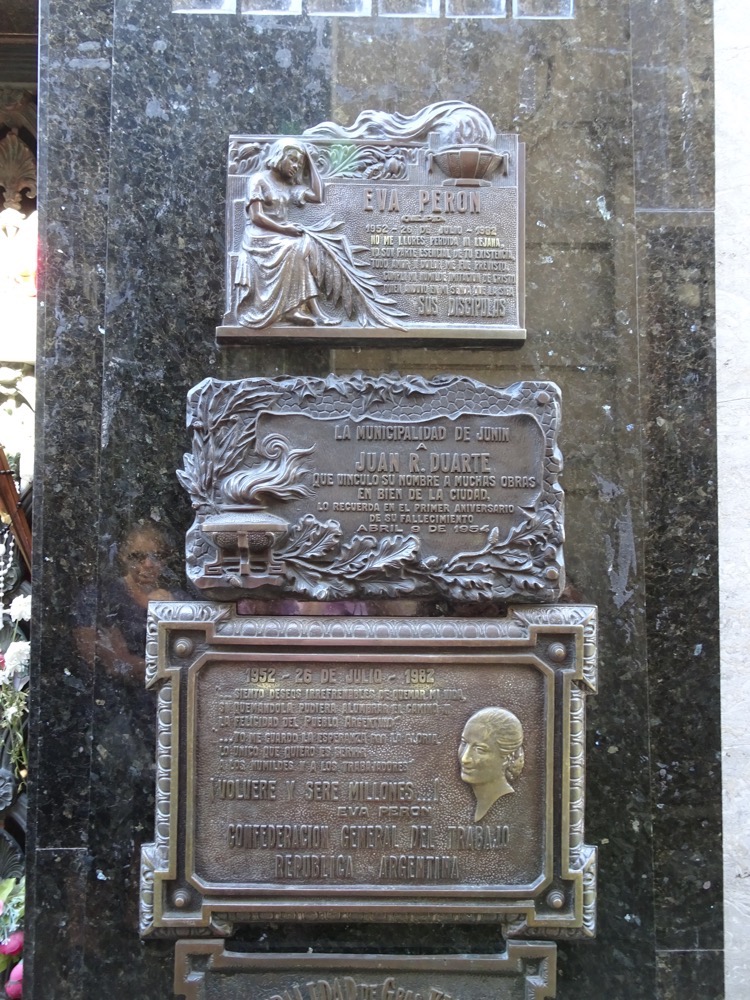
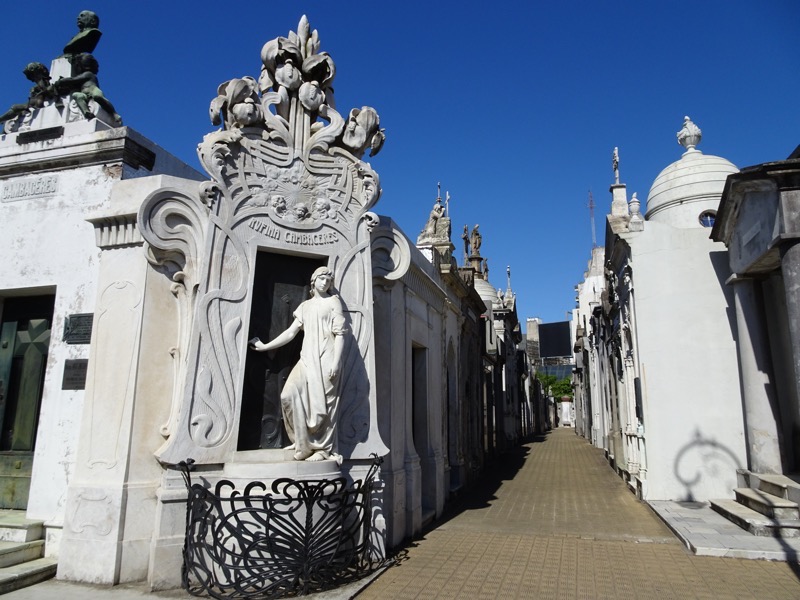
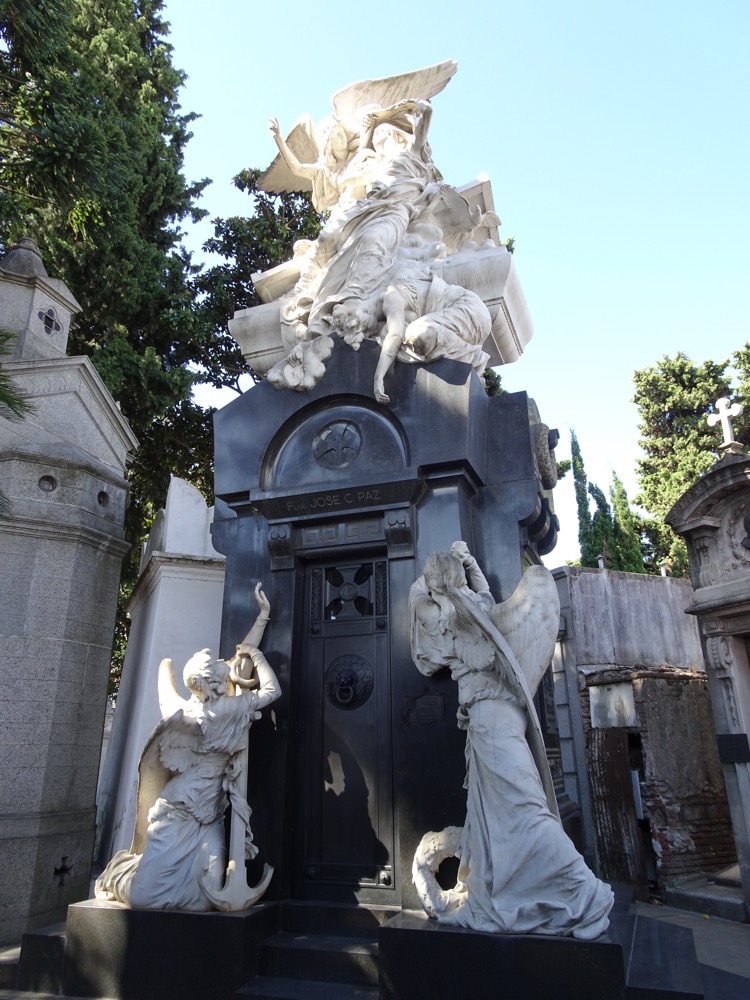
Ceri photographs at the cemetery a lot and is preparing images for a book – which means he knows everyone here very well. As we were leaving we met the security personnel who had plenty of questions for us about kangaroos and Australia’s dangerous wildlife. They were also quite taken with our blue-eyed appearances and before you know it the mate was being offered around. Having tried it before and remembering full well how bloody disgusting it tastes, I managed to avoid it, but this being Trisha’s first time in Argentina and being a good sport, decided to give it a go. Her verdict: “It’s okay.” How very politic of her. 🙂
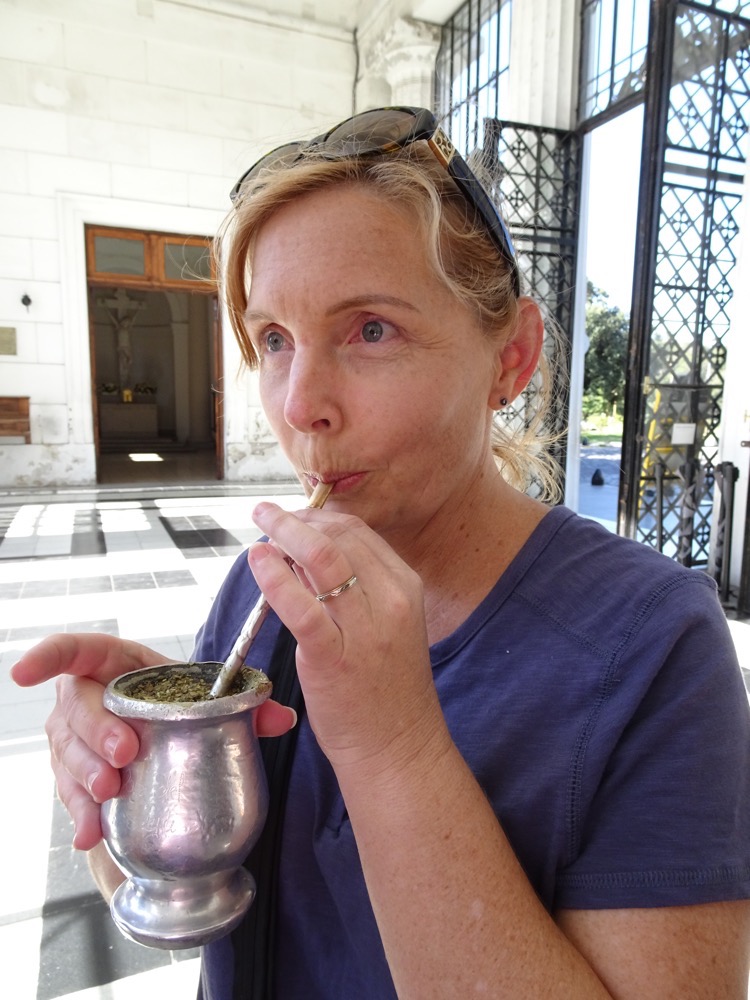
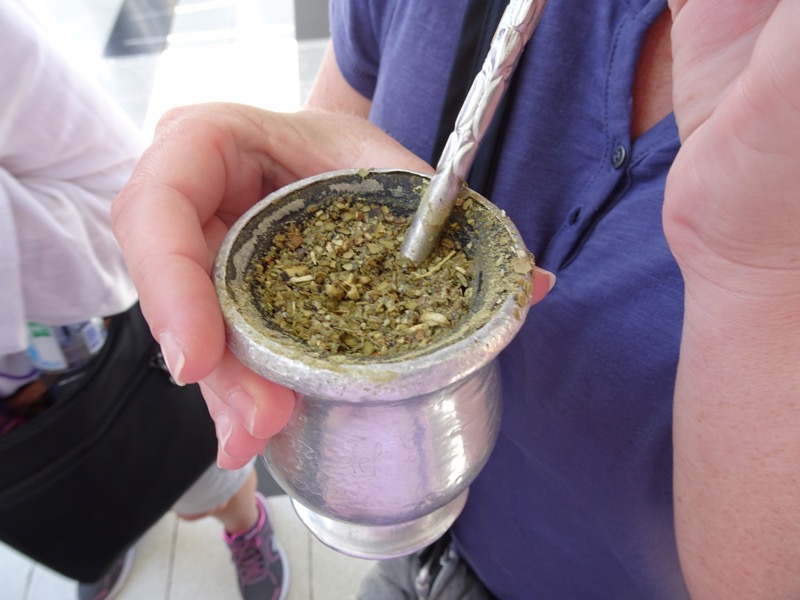
And with that, we concluded our tour at the rooftop bar at our hotel, where we toasted with a lovely bottle of rose, and discussed more about the local culture, politics and religion. It was a very stimulating day all round and I had a wonderful time meeting Ceri.
I hope one day to see the Pope wearing some of his shoes!
